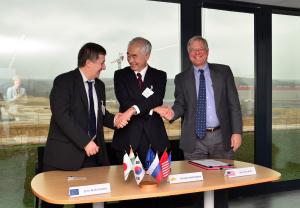Further important steps for diagnostics

"The progress in diagnostics and measurement systems has taken a big step forward this week with the signature of the contracts for six systems between the US Domestic Agency and the ITER Organization, as well as a Memorandum of Understanding (MOU) with the European Domestic Agency relating to the manufacture of port plugs," said Deputy Director-General Dhiraj Bora, head of the CODAC, Heating & Diagnostics Directorate.
The technical specifications for six systems were contained in two Procurement Arrangements. Included was the diagnostic engineering of two upper and one equatorial port and diagnostics that will monitor, amongst other things, the plasma electron density, electron temperature and divertor surface temperature.
One of the diagnostics is based on the principles of interferometry and will use a 10.6-micrometer CO2 laser to probe the plasma and determine the average number of particles per unit volume. Another will use the electron cyclotron emission from the plasma filtered at various magnetic fields in a way akin to that used in medicine's magnetic resonance imaging. This will report the temperature at precise positions deep inside the hot ITER plasma—a plasma easily in the region of 200 million degrees Celsius. A third system will use the infrared emission from the divertor, or lower area in the vacuum chamber, to determine the temperature of the surface. This is similar to the way in which heat loss from buildings is measured. The divertor surfaces have to handle high heat loads from the plasma and need to be kept well below the melting point of the plasma-facing material, e.g., tungsten.
All of the systems will provide measurements that are used to control the plasma. This is an important aspect of optimizing the ITER performance and achieving good quality and long plasma discharges.
The Memorandum of Understanding describes the general principles of how both the ITER Organization and European Domestic Agency, F4E, will cooperate in the purchase of the diagnostic port plug support structures from a common manufacturer. This cooperation will extend to all diagnostic port plugs over the coming months. "This is an important step that aims to reduce the cost to the overall project by bulk ordering of components," explained Dr. Filhol, ITER Department Head at the European Domestic Agency. These port plug structures represent the frames that hold all the diagnostic components that will be used to extract the signals from the plasma through carefully designed labyrinths.
The Eleventh ITER Council meeting at ITER Headquarters last week was an excellent opportunity to sign all the documents. "Moving these Procurement Arrangements forward represents an important milestone in maintaining the project schedule," says Ned Sauthoff, head of the US ITER Project Office.
